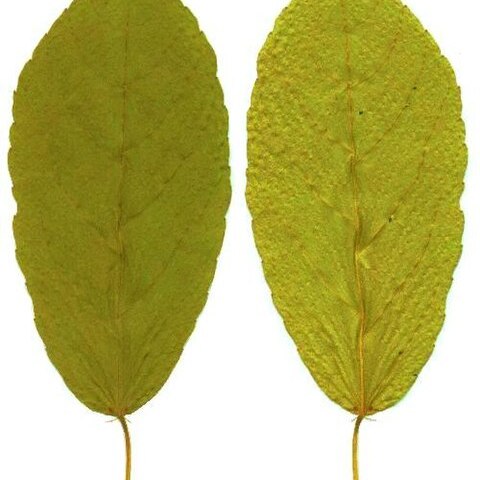A ± erect monoecious but functionally dioecious coppicing shrub or scandent, densely and irregularly branched deciduous small tree of open habit up to 8 m. tall, but more commonly not exceeding 4.5 m., and spreading to 9 m. across.. Bark smooth, brown.. Twigs lenticellate, greyish-or purplish-brown, robust.. Buds perulate, ovoid, 4 mm. long, brown.. Young shoots and petioles sparingly puberulous or subglabrous.. Petioles 1–7(–9) cm. long, commonly with a distal and proximal pulvinus; leaf-blade ovate-lanceolate, oblong-ovate or occasionally somewhat oblong-oblanceolate, 7–18 cm. long, 3–8 cm. wide, obtusely, subacutely or acutely acuminate, often caudate, rounded or occasionally cuneate, shallowly crenate to subentire, membranous, 3-nerved from the base, lateral nerves 4–7(–9) pairs, sometimes with 2(–4) small glandular patches beneath at the base, and occasionally with others elsewhere on the leaf-surface, stipellate, very sparingly puberulous on the midrib and main veins above and beneath, soon glabrescent, but with persistent tufts of hairs in the axils of the main veins beneath, dark green when growing in the shade, yellow-green when growing in the open.. Stipules filiform, setaceous, linear or linear-oblong, 2–7 mm. long, sparingly puberulous or subglabrous. Stipels subulate-filiform, 1–3 mm. long, glabrous.. Male inflorescences axillary, developing on the older twigs after leaf-fall and the development of the fruits, and before or during the development of the new terminal flush of leaves, solitary or more rarely paired, spicate or subracemose, up to 9 cm. long; axis sparingly puberulous or subglabrous; bracts ± ovate, concave, (1.5–)2.5–5 mm. long, 1–2 mm. wide, subacute, ± entire or somewhat erose, minutely puberulous, scarious, chestnut-brown, dense at first, but later laxly disposed along the expanded spike; second-order bracts linear-setaceous, 1–2 mm. long, ciliate.. Male flowers ± sessile or very shortly pedicellate; buds subglobose, 0.7 mm. long, apiculate, sparingly pubescent or subglabrous, greenish white; sepals 2–4(–5), if 2 then suborbicular and cupular, if more then ovate, reflexed; stamens 8–9, the united filaments forming a basal plate; pistillode 0, minute or columnar, up to 0.5 mm. long, 2–3-lobed.. Female inflorescences terminal, solitary or more rarely paired, spicate, few-flowered, lax, up to 15 cm. long, but usually not exceeding 10 cm.; axis very sparingly puberulous or ± glabrous; bracts ovate-lanceolate, 2–3 mm. long, acute, sparingly puberulous, with 2 sessile glands on the axis below the base, 1-flowered; bracteoles linear-lanceolate, 1 mm. long.. Female flowers sessile; sepals 5–6, suborbicular-ovate, 0.5–0.7 mm. long, somewhat unequal, subacute, slightly denticulate, subglabrous; ovary subglobose, scarcely 3-lobed, 1 mm. long, 1.5 mm. diameter, smooth, evenly minutely ad-pressed puberulous; styles (2–)3, united at the base, linear-filiform, (0.3–)0.5–1.5 cm. long, sparingly puberulous beneath at the base, minutely papillose, bright red or pinkish.. Fruits 3(–4)-lobed, 5–7 mm. long, 7–8 mm. diameter, ± smooth, sparingly puberulous.. Seeds ovoid-subglobose, 4 mm. long, 3 mm. wide, ± smooth or slightly rugulose, somewhat shiny, pale yellowish brown.. Fig. 51.
More
Leaf blades 5–17 × 3–8 cm, elliptic-lanceolate to oblong-oblanceolate, acuminate or caudate with the acumen less than one quarter the length of the blade, rounded or cuneate, rarely cordate at the base, shallowly crenate-serrate on the margins, thinly chartaceous, 3-nerved from the base, glandular at the base and sometimes also elsewhere beneath, sparingly pubescent on the midrib and main nerves at first, soon glabrescent except in the domatia, reddish when young.
Female flowers sessile; sepals 5–6, minute, ovate, unequal, subacute, slightly denticulate; ovary 1 × 1.5 mm, subglobose, scarcely 3-lobed, smooth, evenly minutely appressed-puberulous; styles (2)3, up to 1.5 cm long, united at the base, linear-filiform, minutely papillose, red.
Male flowers ± sessile; buds 0.7 mm long, subglobose; sepals 2–4(5), suborbicular and cupular or ovate, reflexed, yellowish-green or white; stamens 8–9, the united filaments forming a basal plate; pistillode absent or minute, columnar, 2–3-lobed.
Male inflorescences up to 12 cm long, axillary, developing on the older twigs usually before the new leaf flush, spicate; bracts 1.5–5 × 1–2 mm, ovate, concave, scarious, chestnut-brown.
Shrub or small tree, up to 6 m high. Leaf base rounded to harrowly lobed, blade usually broadly obovate to broadly oblong, up to 200 x 90 mm, apex attenuate. Flowers red.
A deciduous, ± erect or straggling lax-branched subshrub, shrub or small tree 1–5(10) m high, monoecious, with male and female inflorescences on separate branches.
Female inflorescences usually not more than 10 cm long, terminal, spicate, few-flowered, lax; bracts 2–3 mm long, ovate-lanceolate, biglandular below the base.
Fruits 5–7 × 7–8 mm, 3-lobed, rarely 4-lobed, smooth, sparingly puberulous to subglabrous, dark green, brown or black.
Seeds 4 × 3 mm, ovoid-subglobose, ± smooth or slightly rugulose, somewhat shiny, light brown or greyish.
Young shoots and petioles evenly or sparingly pubescent, puberulous or subglabrous.
Buds perulate (furnished with protective scales), ovoid, chestnut-brown.
Petioles 1–9 cm long, commonly bipulvinate.
Stipules 2–8 mm long, linear to filiform.
Stipels 1–3 mm long, subulate-filiform.
A shrub or small tree, 15–20 ft. high;
Bark smooth, light grey, flaking.
Twigs lenticellate, brownish.
Leaves 3-nerved at the base.


